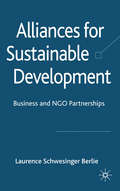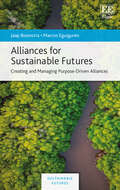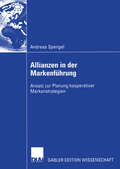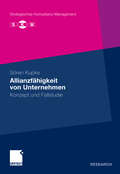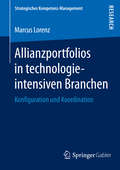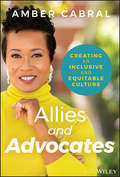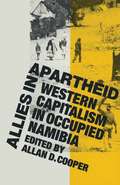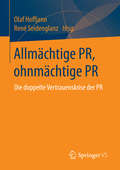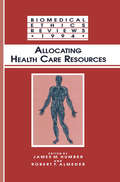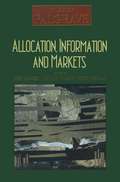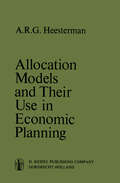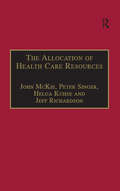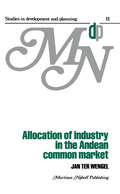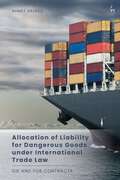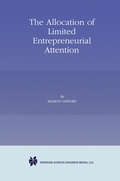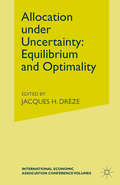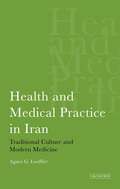- Table View
- List View
Alliances for Sustainable Development: Business and NGO Partnerships
by L. BerlieA lively and hands-on exploration of corporate-NGO alliances. It offers original insight to understand why alliances exist and to what end. It also looks into the asymmetries between partners and dwells on three crucial aspects of alliances management : alliance capacity development, stakeholder involvement and alliance metrics.
Alliances for Sustainable Futures: Creating and Managing Purpose-Driven Alliances (Sustainable Futures)
by Jaap Boonstra Marcos EguigurenProviding an in-depth exploration of the formation, building, development, and evolutionary phases of sustainable alliances, this book presents a new perspective on organizational change that goes beyond modern institutions and offers practical insights on how to cope with paradoxes in the life cycle of alliances. Combining theoretical ideas, practical concepts, and critical reflections on the topic, this insightful and timely book supports the conception and progression of purpose-driven alliances which contribute to a more positive and sustainable world. The authors present a historical overview of alliances, as well as discussing the factors pertaining to the successes and failures of collaborating organizations. The book further outlines the life cycle of sustainable alliances, using the Global Alliance in Management Education (CEMS) and the Global Alliance for Banking on Values (GABV) as contemporary case studies. Analysing the strength and scope of alliances, it explores opportunities for these partnerships to contribute to a sustainable future. Offering inspiration and guidance for those looking to contribute to profound economic and social change, this book will be an invaluable resource for students and scholars of business management, international business, and sustainable development, as well as the new generation of business people. It will also be beneficial for consultants, leaders, and managers who are dedicated to the creation and development of global alliances.
Allianzen in der Markenführung: Ansatz zur Planung kooperativer Markenstrategien
by Andreas SpengelAndreas Spengel untersucht, welche Chancen und Risiken sich aus der externen Wachstumsoption strategischer Markenallianzen ergeben. Im Mittelpunkt steht die fundierte Analyse dominanter Phänotypen von Markenallianzen und ihre Bewertung im Hinblick auf die verfolgten Zielsetzungen.
Allianzfähigkeit: Konzeption, Messung, Determinanten, Auswirkungen (Marktorientierte Unternehmensführung und Internetmanagement)
by Oliver SchilkeAuf der Basis des ressourcentheoretischen Ansatzes identifiziert Oliver Schilke zentrale Dimensionen, Determinanten und Konsequenzen der Allianzfähigkeit. Auf der Grundlage einer Befragung von 302 Unternehmen der Branchen Chemie, Maschinen- und Fahrzeugbau zeigt er, dass Allianzfähigkeit sich anhand der Dimensionen interorganisationale Koordination, Allianzportfoliokoordination, interorganisationales Lernen, Allianzproaktivität und Allianzanpassung bestimmen und messen lässt.
Allianzfähigkeit von Unternehmen: Konzept und Fallstudie (Strategisches Kompetenz-Management)
by Sören KupkeSören Kupke erläutert die Motive von Unternehmen und deren Strategien zum Eingehen strategischer Allianzen. Vor dem Hintergrund der Fragestellung, warum es einigen Unternehmen gelingt, strategische Allianzen erfolgreich aufzubauen, wird der fähigkeitsorientierte Ansatz als geeignete theoretische Grundlage identifiziert.
Allianzportfolios in technologieintensiven Branchen: Konfiguration und Koordination (Strategisches Kompetenz-Management)
by Marcus LorenzAllianzen stellen im heutigen Wettbewerb ein wichtiges Instrument zum Aufbau und Erhalt der Wettbewerbsfähigkeit dar. Sowohl die Forschung als auch die Praxis betrachten Kooperationen jedoch meist als individuelle Erscheinungen, ohne mögliche Synergien und Konflikte genauer zu analysieren. Zur Ermittlung dieses Portfolioeffektes entwickelt Marcus Lorenz einen konzeptionellen Bezugsrahmen, der es ermöglicht, Kooperationsaktivitäten von Unternehmen einer ganzheitlichen Analyse zu unterziehen. Im Mittelpunkt steht dabei die Konfiguration des Allianzportfolios. Anhand einer Längsschnittanalyse von 60 führenden Unternehmen leitet er Handlungsempfehlungen für die Praxis ab. Die Studie liefert damit wichtige Ansatzpunkte, Kooperationen einem aktiven und ganzheitlichen Management zugänglich zu machen.
Allies and Advocates: Creating an Inclusive and Equitable Culture
by Amber CabralLearn to create an inclusive environment with this actionable and insightful resource Allies and Advocates: Creating an Inclusive and Equitable Culture delivers a powerful and useful message about inclusion and diversity in everyday life. Author Amber Cabral, a celebrated inclusion strategist, speaker, and writer, shows readers how to move away from discriminatory and unjust behaviors to supporting and building meaningful connections with people across our diverse backgrounds and identities. While some books settle for vague advice and catchphrases, readers of Allies and Advocates will benefit from the book’s: Straightforward style and applicable action items Real-world examples highlighting inclusion best practices Implementable tactics to assist people in seeing how they can help create an inclusive environment Perfect for anyone who works in a professional environment, Allies and Advocates is especially useful for those in middle and upper management and those involved in the training and orientation of employees. If you are looking forward to building a culture of inclusivity at work or in your personal relationships, and want to learn how to use your privilege to be a better ally, Allies and Advocates: Creating an Inclusive and Equitable Culture is a must-have.
Allies and Advocates: Creating an Inclusive and Equitable Culture
by Amber CabralLearn to create an inclusive environment with this actionable and insightful resource Allies and Advocates: Creating an Inclusive and Equitable Culture delivers a powerful and useful message about inclusion and diversity in everyday life. Author Amber Cabral, a celebrated inclusion strategist, speaker, and writer, shows readers how to move away from discriminatory and unjust behaviors to supporting and building meaningful connections with people across our diverse backgrounds and identities. While some books settle for vague advice and catchphrases, readers of Allies and Advocates will benefit from the book’s: Straightforward style and applicable action items Real-world examples highlighting inclusion best practices Implementable tactics to assist people in seeing how they can help create an inclusive environment Perfect for anyone who works in a professional environment, Allies and Advocates is especially useful for those in middle and upper management and those involved in the training and orientation of employees. If you are looking forward to building a culture of inclusivity at work or in your personal relationships, and want to learn how to use your privilege to be a better ally, Allies and Advocates: Creating an Inclusive and Equitable Culture is a must-have.
Allies in Apartheid: Western Capitalism in Occupied Namibia
by Allan D. CooperEleven of the world's leading scholars on Namibia offer a collection of articles that provide an examination of the importance of Namibia to each of the major Western capitalist powers, and analyze the extent to which each power contributes to South Africa's continuing occupation of Namibia.
Allmächtige PR, ohnmächtige PR: Die doppelte Vertrauenskrise der PR
by Olaf Hoffjann René SeidenglanzThema des Bandes ist die doppelte Vertrauenskrise der PR: Wer vertraut PR-Praktikern überhaupt? Journalisten und kritische Öffentlichkeit stehen dem Berufsfeld zunehmend skeptisch gegenüber. Greenwashing, Spin-Doctoring, heimlicher Verführer sind nur einige Schlagwörter, hinter denen die Unterstellung steht, dass PR (zu) oft erfolgreich manipuliere. Man misstraut der PR, weil man sie für mächtig hält, aber gleichermaßen auch, weil man sie als wirk- und machtlos empfindet. Hier setzt dieser Band an. Die Beiträge analysieren, worin Vertrauen in PR besteht und wie es sich theoretisch fassen lässt. Sie beschreiben, wie vertrauenswürdig Journalisten, Öffentlichkeit oder Top-Management die PR tatsächlich einschätzen. Der Band geht auf Strategien ein, mit denen PR sich als vertrauenswürdig zu inszenieren sucht und klärt, wie sie wirklich vertrauenswürdiger werden kann. Es wird aber auch aufgezeigt, wie PR ihrer eigenen Vertrauenswürdigkeit schadet.
Allocating Health Care Resources (Biomedical Ethics Reviews)
by James M. Humber Robert F. AlmederIn ALLOCATING HEALTH CARE RESOURCES, leading authorities and researchers expose the basic philosophical, ethical, and economic issues underlying the current health care debate. The contributors wrestle with such complicated issues as whether it is ethical to ration health care, the morality of the worldwide bias against children in allocating health care resources, whether sin taxes can be defended morally, and how to achieve a just health care system. The book also includes an insightful analysis of the Clinton health care reform plan. ALLOCATING HEALTH CARE RESOURCES will be of interest to philosophers, health policy experts, medical ethicists, health professionals, and concerned citizens. It serves to clarify and illuminate the logic and rhetoric of health care reform, and so to help us all achieve a fair and equitable distribution of these precious resources.
Allocating Pensions to Younger People: Towards a Social Insurance against a Short Life
by Gregory PonthiereThis book takes as a starting point that welfare states in developed societies do not provide systems of social insurance against the risk of an early death. In contrast to the way in which economically developed countries provide ways of insuring citizens against other possibilities, such as unemployment and disease, no such social insurance mechanism exists for early death. It aims to demonstrate that, despite the impossibility to compensate the victims of a short life once they are identified, and despite the impossibility to identify the persons who will be short-lived (when they are still alive), it is nonetheless possible to construct a social insurance against the risk of a short life by means of age-based statistical discrimination favouring all young persons. Combining philosophical literature with economic analysis, the book re-examines the ethical foundations of social insurance, and proposes a major reform of the welfare state: the construction of a social insurance against a short life. It shows how such an insurance system could be constructed by partially ‘reversing’ existing pension systems, by offering a period of retirement to all young adults before they start their career. Such a ‘reversed’ pension system would allocate more free time and opportunities to younger members of society before they enter the labour market, and, hence, this system would also improve the lives of the – unidentified – young persons who will turn out to die prematurely. The book discusses the social desirability of this new system, as well as its financial feasibility and societal consequences, examining how pension allowances paid to young adults may be financed by the work of senior workers. As such, this book demonstrates how the universal uncertainty about the duration of life can be reconciled with the idea of social justice. With an accessible and interdisciplinary approach, this book will be of interest to academics working in a range of fields, including economics, public finance, social insurance, the economics of ageing and the welfare state, economic ethics and political philosophy.
Allocating Taxing Powers within the European Union (MPI Studies in Tax Law and Public Finance)
by Isabelle Richelle Wolfgang Schön Edoardo TraversaThe contributions to this volume try to overcome the traditional approach of the judicature of the European Court of Justice regarding the application of the fundamental freedoms in direct taxation that is largely built on a non-discrimination test. In this volume, outstanding authors cover various aspects of the national and international tax order when European law meets domestic taxation. This includes testing traditional pillars of income taxation – ability-to-pay, source and residence, abuse of law, arm’s length standard – with respect to their place in the emerging European tax order as well as substantial matters of co-existence between different tax systems that are not covered by the non-discrimination approach such as mutual recognition, cross-border loss compensation or avoidance of double taxation. The overarching goal is to flesh out the extent to which a substantive “allocation of taxing powers” within the European Union is on its way to a convincing overall framework and to stretch the discussion “beyond discrimination”.
Allocation, Information and Markets (The New Palgrave)
by John Eatwell Murray Milgate Peter NewmanThis is an extract from the 4-volume dictionary of economics, a reference book which aims to define the subject of economics today. 1300 subject entries in the complete work cover the broad themes of economic theory. This volume concentrates on the topic of allocation information and markets.
Allocation Models and their Use in Economic Planning (International Studies in Economics and Econometrics #3)
by Aaart R. HeestermanThree different lines of approach have contributed to the theory of optimal planning. One approach considers the problem from the view-point of a national government and its adviser, the econometrician planning speci alist. The government can, if this is thought to be desirable, stimulate investment in certain directions and discourage other economic activities. By various fiscal devices, it can influence both the total level and the distribution of investment funds over different sectors of production. Also, in many countries, a public agency plays some kind of coordinat ing role in the formulation of long-term plans for output by the enter prises sector; this may range from administrative direction in so-called centrally planned economies, to persuasion and advice in 'capitalist' economies. Accordingly, the public planner wishes to know what dis tribution of the nation's resources would be 'optimal'. This leads to the construction of various models which may be described under the general heading 'input-output type models'. This type of model has been largely developed by practitioners, among whom Sandee [B2] is probably the most outstanding and the earliest. A later, well-developed example of a model based on this approach is, for example, the Czech model by Cerny et al. [Bl]. A second approach considers the problem from the point of view of the private entrepreneur and his adviser, the manager and financial accountant.
The Allocation of Health Care Resources: An Ethical Evaluation of the 'QALY' Approach (Medico-Legal Series)
by John McKie Peter Singer Jeff RichardsonThe competition for limited health care resources is intensifying. We urgently need an acceptable method for deciding how they should be allocated. But the goods that health care produces are of very different kinds. Health care can extend the lives of children and of older people. It can make it possible for a person to walk, when without health care that person would be permanently bedridden; and it can reduce the pain and distress of people who are terminally ill. How can we possibly decide which of these - and many more - diverse achievements of health care are more deserving than others? We need a common unit by which we might be able to measure these very different goods. The Quality-Adjusted Life Year, or QALY, is the most developed proposal for such a unit of measure. In this book a distinguished team of ethicists and economists defend the core of the QALY proposal: that health care resources should be used so as to produce more years of life, of the highest possible quality. This leads to a discussion of such fundamental questions as whether all lives are of equal value, whether health care should be allocated on the basis of need and whether the QALY approach incorporates an adequate account of fairness or justice. The result is the most thorough account yet of the ethical issues raised by the use of the QALY as a basis for allocating health care resources.
The Allocation of Health Care Resources: An Ethical Evaluation of the 'QALY' Approach (Medico-Legal Series)
by John McKie Peter Singer Jeff RichardsonThe competition for limited health care resources is intensifying. We urgently need an acceptable method for deciding how they should be allocated. But the goods that health care produces are of very different kinds. Health care can extend the lives of children and of older people. It can make it possible for a person to walk, when without health care that person would be permanently bedridden; and it can reduce the pain and distress of people who are terminally ill. How can we possibly decide which of these - and many more - diverse achievements of health care are more deserving than others? We need a common unit by which we might be able to measure these very different goods. The Quality-Adjusted Life Year, or QALY, is the most developed proposal for such a unit of measure. In this book a distinguished team of ethicists and economists defend the core of the QALY proposal: that health care resources should be used so as to produce more years of life, of the highest possible quality. This leads to a discussion of such fundamental questions as whether all lives are of equal value, whether health care should be allocated on the basis of need and whether the QALY approach incorporates an adequate account of fairness or justice. The result is the most thorough account yet of the ethical issues raised by the use of the QALY as a basis for allocating health care resources.
Allocation of Industry in the Andean Common Market (Studies in Development and Planning #11)
by J. ter WengelThe objective of this text is to develop and implement a model for allocating the industries of the Sectorial Programs of Industrial Development of the Andean Common Market. In the Andean Common Market, as in most other integration schemes among less developed countries, the main expectations regarding the promotion of economic growth are based on the expectation of increased opportunities for import substituting industrialization. The concern here is with the Andean Common Market in particular because it has been the economic integration scheme that has most explicitly recognized the objective of the less developed countries of taking advantage of the new opportunities for industrial ization created by the combination of the individual markets. In the Andean Common Market the importance attached to the expectation of the gains from industrialization was expressed in the formulation of Sectorial Programs of Industrial Development. Other integration schemes among less developed coun tries have not addressed the issue of import substituting industrialization in such detailed manner. In the first section of this chapter the importance of the topic of allocating industries in integration schemes among less developed countries is discussed. It is argued that the benefits to be derived from increased trade in the traditional products of the member countries are minimal. Instead, the member countries 1 2 ALLOCATION OF INDUSTRY IN THE ANDEAN COMMON MARKET expect the benefits from economic integration schemes to be derived from the utilization of the opportunities for industrialization created by such schemes.
Allocation of Liability for Dangerous Goods under International Trade Law: CIF and FOB Contracts
by Ahmet GelgeçThis book explores the allocation of risk and liability of dangerous goods between the seller and the buyer under CIF (Cost, Insurance and Freight) and FOB (Free on Board) contracts, providing an in-depth study of the issue of carriage of dangerous goods in the context of international trade law. In addition to offering specific solutions to issues arising in the context of the contract of sale, the book provides a non-contractual angle, putting forward suggestions under non-contractual mechanisms. Importantly, the book incorporates case law examples from the Commonwealth and the US.Dangerous goods that are carried by sea can cause potential risks of losses and damages to the vessel, other cargoes and lives on board. The allocation of liability arising out of the carriage of dangerous goods has recently attracted unwelcome attention because of mis–declared cargoes leading to fires on board ships. Thus the book fills a gap in the literature by addressing the issue in detail with examples from multiple jurisdictions, and proposing solutions. In particular, the book analyses whether and to what extent the law of international sale of goods can provide any assistance in the re-allocation of liability between the buyer and the seller.This book will be of great interest to all those involved in the research as well as legal practice of international trade law and the law of carriage of goods by sea.
Allocation of Liability for Dangerous Goods under International Trade Law: CIF and FOB Contracts
by Ahmet GelgeçThis book explores the allocation of risk and liability of dangerous goods between the seller and the buyer under CIF (Cost, Insurance and Freight) and FOB (Free on Board) contracts, providing an in-depth study of the issue of carriage of dangerous goods in the context of international trade law. In addition to offering specific solutions to issues arising in the context of the contract of sale, the book provides a non-contractual angle, putting forward suggestions under non-contractual mechanisms. Importantly, the book incorporates case law examples from the Commonwealth and the US.Dangerous goods that are carried by sea can cause potential risks of losses and damages to the vessel, other cargoes and lives on board. The allocation of liability arising out of the carriage of dangerous goods has recently attracted unwelcome attention because of mis–declared cargoes leading to fires on board ships. Thus the book fills a gap in the literature by addressing the issue in detail with examples from multiple jurisdictions, and proposing solutions. In particular, the book analyses whether and to what extent the law of international sale of goods can provide any assistance in the re-allocation of liability between the buyer and the seller.This book will be of great interest to all those involved in the research as well as legal practice of international trade law and the law of carriage of goods by sea.
The Allocation of Limited Entrepreneurial Attention
by Sharon GiffordThe Allocation of Limited Entrepreneurial Attention examines the implications of allocating limited entrepreneurial attention among activities or projects. This book maintains that attention is simultaneously limited in that a decision maker can pay attention to only one thing at a time, and entrepreneurial in that it may be allocated to evaluating a potential new project for possible adoption. However, since the outcome of the allocation of attention is not certain, the number of projects among which attention can be allocated is stochastic and the maximum number of projects is endogenously determined by the optimal allocation of limited entrepreneurial attention and describes the implications of this analysis for a number of economic problems.
Allocation under Uncertainty: Equilibrium and Optimality (International Economic Association Series)
by Jacques H. ÈzeAllokation der Eigentumsrechte an Unternehmensberatungen: Eine ökonomische Analyse (ebs-Forschung, Schriftenreihe der EUROPEAN BUSINESS SCHOOL Schloß Reichartshausen #61)
by Katrin SchröderKatrin Schröder analysiert die Bedingungen der Allokation von Eigentumsrechten an Partner bzw. an unternehmensexterne Investoren. Die Ergebnisse zeigen, dass Kapitalbedarf, Geschäftsrisiko, Agency-Kosten und die Kosten kollektiver Entscheidungen die Eigentumsallokation bei Unternehmensberatungen entscheidend beeinflussen.
Allopathy Goes Native: Traditional Versus Modern Medicine in Iran
by Agnes LoefflerAllopathy is often described as 'western' medicine, the antithesis of homeopathy, yet all medical systems are infused with culture-specific values, ideas and beliefs. Agnes Loeffler's insightful and original book investigates how allopathic knowledge, theories and practice guidelines come to be understood and applied by practitioners in a non-western context. Based on research amongst doctors in Iran, Loeffler describes how the system of allopathic medicine has adapted to local explanations of health and disease and to the economic, social and religio-political realities framing contemporary Iranian life and culture. This approach simultaneously problematizes the view of allopathic medicine as a 'western' entity exerting a hegemonic influence over non-western cultures, and provides a rare glimpse of the complexities of modern Iran society - exploring the interfaces between culture, health and the experience of illness.
Alltagscoaching 360°: Private und berufliche Selbststärkung von A - Z
by Anette Schunder-HartungDas Buch stellt in Essayform 85 sorgfältig aufbereitete Lebensthemen zum Selbststudium zusammen: von A – Z, zum Lesen, Nachschlagen und zum praktischen Nachvollziehen. Dabei kommen Herausforderungen aus unserer persönlichen Sphäre ebenso zum Tragen wie besondere Aspekte unseres Arbeitslebens.Um Ihnen einen raschen Überblick zu verschaffen, sind die einzelnen Abschnitte je nach Schwerpunkt als privat oder beruflich gekennzeichnet. Bestimmte Grundsatzfragen wie Liebe und Respekt, das männliche und weibliche Prinzip in Yin und Yang, der Umgang mit Krankheiten und schließlich das große Thema Zukunft werden besonders ausführlich erörtert. Für Motivationskrisen bekommen Sie eine leicht zu merkende Soforthilfe-Formel. Ein System von Verweispfeilen unterstützt Sie beim Vertiefen wiederkehrender Alltagsfragen. Kurze, prägnante Leitsätze können Sie am Schluss des Buches mit eigenen Anmerkungen verbinden. Ein umfangreiches Literaturverzeichnis aus öffentlich zugänglichen Quellen rundet Ihre Lektüre ab.
